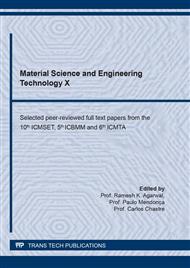p.303
p.309
p.315
p.323
p.331
p.338
p.345
p.352
p.358
Blended Basic Oxygen Furnace (BOF) Slag with Ground Granulated Blast Furnace Slag (GGBFS) as a Pozzolanic Material
Abstract:
As one of the by-products in the steel industry, granulated blast furnace slag (GBFS) is widely used as an aggregate or a pozzolanic material (a partial replacement for Portland cement) in the concrete mixture after the crushing or grinding process. However, using a basic oxygen furnace slag (BOFS) as a cementitious material is limited because of its inherent shortcomings such as low cementing property and undesirable expansion characteristics due to free lime. To overcome BOFS’s these properties, the BOFS was ground, blended with the ground granulated blast furnace slag (GGBFS), and used as a pozzolanic material in this research. A total of five mortar mixtures were developed, including ordinary Portland cement (OPC) as a control group, two binary mixtures, and two ternary blended mixtures with 50% cement replacements by GGBFS and BOFS by weight percentages. Properties of these mixtures were evaluated according to ASTM C 989 and C 311 standard specifications that include compressive strength, alkali-silica reaction (ASR), and sulfate resistance tests. Moreover, basic material characterization of GGBFS and BOFSs was investigated by X-ray diffraction (XRD), chemical composition analysis (XRF), and particle size distribution (PSD). The test result shows that the blended mixture with 15% BOFS and 35% GGBFS satisfied the strength activity index and good ASR and sulfate resistance.
Info:
Periodical:
Pages:
331-337
Citation:
Online since:
February 2022
Price:
Сopyright:
© 2022 Trans Tech Publications Ltd. All Rights Reserved
Share:
Citation:


